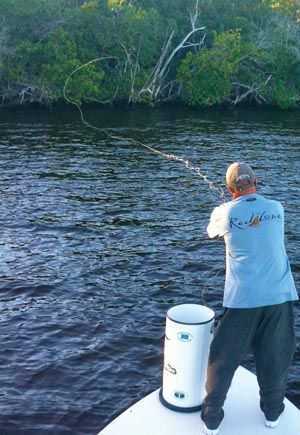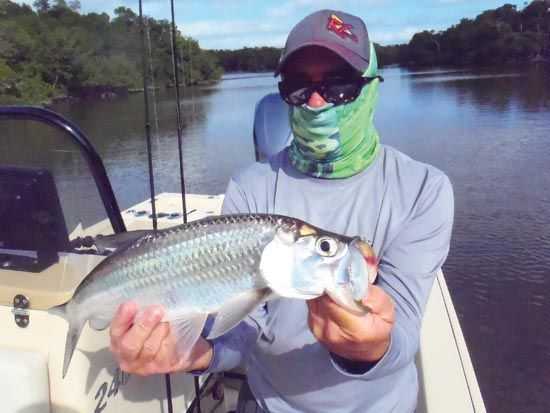By Capt. Michael Manis
I was fortunate to get the chance to grow up during a time when machines and devices didn’t control so much of our lives. Back then, it was wilderness where we went to spend time. Depending on where you go, wilderness is a relative term. However, having spent most of my years in Florida, backcountry flats surrounded by mangroves are the wilderness I know best. I remember the upper Keys before development when that’s all it was. And, although I’ve been to Everglades National park many times over the last 20 years, I’ll never forget my first trip to Flamingo. Today, it’s nothing more than a campground with a small marina. Even before the park was established, it was never any more than an outpost. It’s accessed through Homestead at the bottom of the mainland. It sits on the southern edge of the park that is bordered by Everglades City and Chokoloskee to the north. The entire area is part of the largest wilderness area of its kind: the 10,000 islands.
At the northern end, Everglades City, although still a small town, offers amenities that can’t be found in Flamingo. Things like a few hotels and restaurants. It’s a small town but hot water and food are a real treat after a long day on the water. Not to mention, a place to escape from the mosquitos and no see-ums. Until you learn your way around, it’s a bit, no, a lot more difficult navigating at this end of the park. It’s shallow and there’s lots more oyster bars and a lot fewer channel markers. There are large river systems up here, but hard bottom is abundant. It’s a good run to the middle river systems from both ends, places like the Lostman’s, Rodgers, Broad and Shark.
Beginning with the small tidal creeks that come out of the Everglades that feed the countless finger systems and eventual rivers that dump into the gulf, the diversity of the fishery is extensive. If you travel far enough east bass are even an option. For me, what made and still continues to make the fishing special is how the fish are eager to eat artificial baits. They are in more of a natural and wild environment and aren’t pressured and haven’t been consistently fed the live bait that the fish in more populated areas see. I generally fish for snook, redfish and tarpon and see lots of trout, mangrove snapper, sharks and jack crevalle along the way. In fact, I’ve never seen more jacks anywhere. Talk about a great day on fly. With spinning or bait casting gear, it’s a great place to explore by working a soft plastic or feathered jig up against any shoreline.
Like anywhere, the fish move with the seasons and depending on when I go will dictate where I like to look. Generally, during cooler months, back country bay and creek systems can be good. In years past, In October, fishing out of Flamingo, I’ve had some good days fishing snook and tarpon on the Lane River and inside Hell’s Bay. Also, on the west side of Whitewater Bay, Mud Bay is one of my favorite places to look for laid up tarpon.
The last time I was there, this past December, I was able to catch a grand slam: trout, redfish, snook, and tarpon, on fly. That day, we left Flamingo from the Florida Bay side and fished way up some creek systems by going up around Cape Sable. There’s nothing like running off the beaches at the southern edge of the state. Another bonus of loading out of Flamingo, there are two ramps separated by a lock. One ramp leads into the backcountry and one puts you right into Florida Bay where a run to Key Largo or Islamorada is an option. As a matter of fact, places like Snake Bight and the largest pole troll zone anywhere with pristine turtle grass flats are just outside the ramp. The flats adjacent and to the east of Snake Bight channel are a great place to sight fish for redfish. It’s not unusual to see tailing fish. Just off the pole troll zone to the south east where the water drops off to about four feet is tarpon country. In winter, on extremely low tides when all the water drops off the pole troll zone, Snake Bight Channel is loaded with fish. You’ll know its right when the flat looks like dry ground. Everyone fishes the edge where it drops off. A soft plastic on a jig head is as good as anything.
Taking into account that the park encompasses almost 1.5 million acres and is the largest subtropical wilderness in the United States, words can’t do it justice. By adding the prospect of Florida Bay, the fishing opportunities are endless. Moreover, being a national park, only recreational, not commercial fishing is permitted. All in all, the park offers way too much to spend too much time in any one spot. We’re fortunate that this much wilderness has been set aside. So, if you ever get the chance, explore as much of it as you can. The wind is the only factor that should keep you from looking at new country each and every day.
[easy-social-share]


